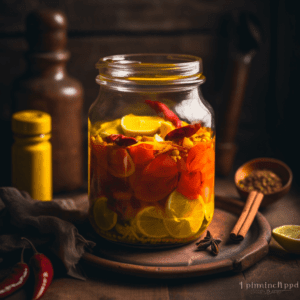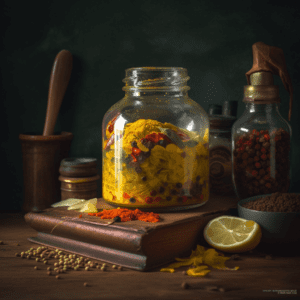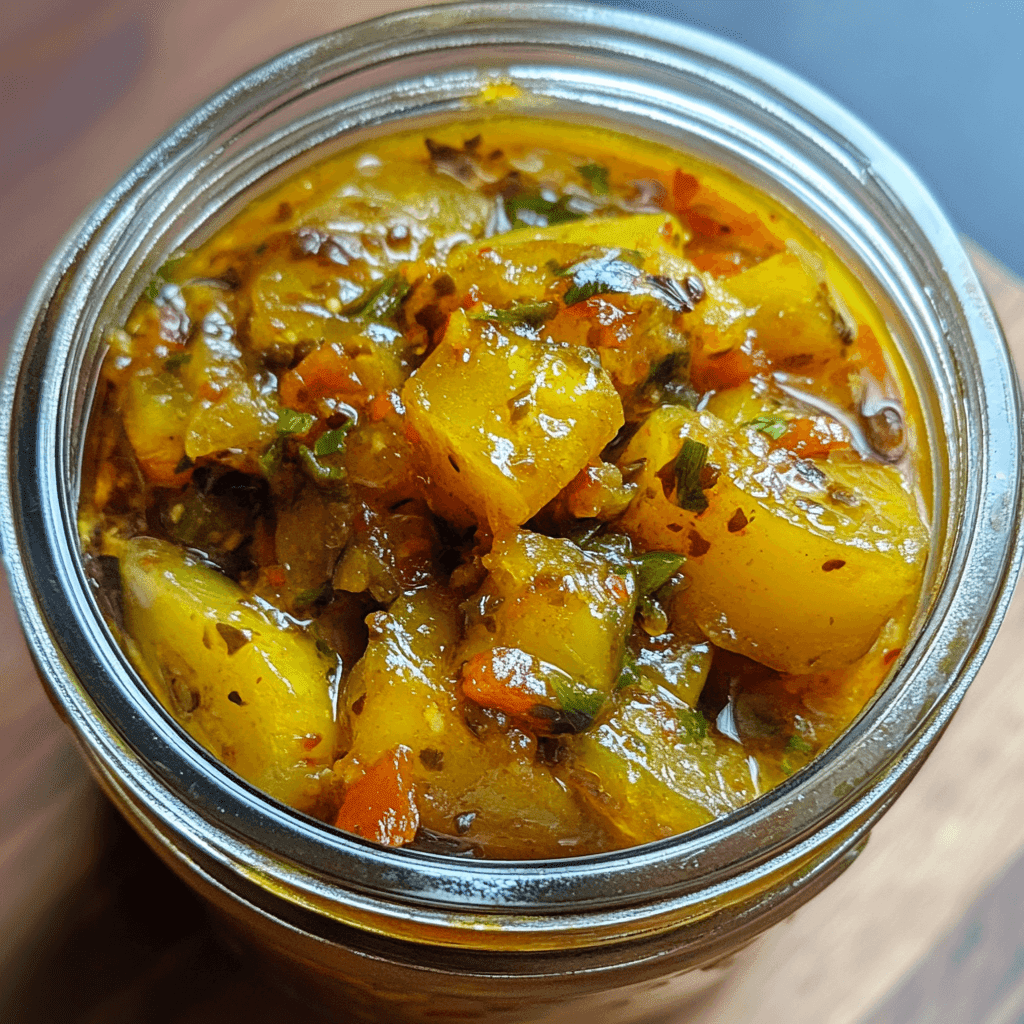Introduction
Indian lime pickle is much more than just a condiment—it is a vibrant slice of cultural heritage that has been passed down through generations. If you’ve ever asked yourself, “How long does Indian lime pickle last?” then you’re about to dive into a world of culinary tradition, scientific preservation methods, and practical storage tips. This article is designed to be your comprehensive guide, explaining the fascinating history behind this spicy delight, the intricate process of its preparation, and the secrets to maintaining its robust flavor and extended shelf life.
The origins of Indian lime pickle trace back centuries when preserving food was not merely an option but a necessity. Before modern refrigeration became common, families relied on natural ingredients like salt, oil, and spices to create pickles that could last for months. The art of pickling was as much about flavor as it was about survival. Over time, these recipes evolved into the diverse and delicious variations we enjoy today.
In the following sections, we’ll explore every aspect of Indian lime pickle—from its humble beginnings to the precise steps required in its creation. We’ll also discuss various preservation techniques, modern storage recommendations, and even the nutritional benefits that make this pickle a must-have addition to your meals. Whether you’re a long-time enthusiast or new to the world of Indian pickles, this guide will arm you with all the necessary knowledge to enjoy your pickle safely and deliciously. Let’s get started!
The History and Cultural Significance
Indian lime pickle is steeped in history and cultural significance. Its evolution mirrors the rich tapestry of Indian culinary traditions and the resourcefulness of ancient communities. Through innovative methods of food preservation, families were able to capture the essence of seasonal produce, ensuring that delicious flavors were available all year round.
Early Beginnings
The inception of Indian lime pickle dates back to ancient times when the lack of modern preservation methods forced people to rely on nature’s own mechanisms. Before the days of refrigerators, preserving food was essential, especially in regions with hot climates. Limes, with their inherent acidity, played a pivotal role in this process. Early picklers discovered that combining limes with salt, spices, and oil not only enhanced the flavor but also created an environment inhospitable to harmful bacteria.
This method of preservation was initially passed down orally from one generation to the next, with each family adding its own special twist. The process was as much an art as it was a science, with careful attention paid to the quality of ingredients and the precise timing of each step. Families learned to judge the perfect moment when the flavors were fully melded, marking the completion of a batch that could be enjoyed for months.
Regional Variations
One of the most intriguing aspects of Indian lime pickle is the regional diversity in its preparation. Every region of India boasts its unique recipe, influenced by local spices, climate, and available ingredients. In the southern parts of India, where the climate is hotter, pickles tend to be spicier, ensuring that they withstand the intense heat. Northern variations, on the other hand, might incorporate a slight sweetness or a different blend of spices to suit regional palates.
This regional variation has not only kept the tradition alive but also enriched the culinary landscape of India. Each jar of lime pickle carries with it a story—a blend of history, local ingredients, and the personal touch of the maker. Even today, many families guard their secret recipes closely, handing them down as treasured heirlooms. Such cultural significance ensures that Indian lime pickle remains a beloved staple, celebrated for both its taste and its historical importance.
Ingredients and Preparation Methods
Creating the perfect Indian lime pickle requires precision, tradition, and a bit of culinary artistry. The recipe involves a careful selection of ingredients, each playing a crucial role in not only enhancing flavor but also in preserving the pickle for an extended period.
Key Ingredients
At the heart of Indian lime pickle are a few key ingredients that contribute to its unique flavor and long shelf life:
- Limes: The star ingredient, fresh and unblemished limes, provide the necessary tang and acidity. Their natural pH plays a critical role in preservation.
- Salt: More than just a flavor enhancer, salt is a natural preservative. It draws out moisture from the limes, creating an environment that limits bacterial growth.
- Spices: Traditional spices such as mustard seeds, fenugreek, turmeric, red chili powder, and asafetida (hing) are used generously. These spices not only add a complex flavor profile but also contribute antimicrobial properties.
- Oil: Typically, mustard oil is the preferred choice for its robust flavor and preservative qualities. Oil creates a barrier against air, further preventing spoilage.
- Acidity Enhancers: Some recipes call for additional vinegar or lemon juice to boost acidity, ensuring a longer shelf life.
Step-by-Step Preparation Process


- Cleaning and Cutting: Begin by thoroughly washing the limes to remove any impurities. Cut them into small pieces or wedges, ensuring that any blemished parts are removed to maintain quality.
- Salting: Once the limes are prepared, mix them with a generous amount of salt. This process is crucial as salt extracts moisture, initiating the preservation process.
- Preparing the Spice Mix: In a separate bowl, roast and grind the spices lightly. This step releases the essential oils in the spices, intensifying the flavor.
- Mixing and Marination: Combine the salted limes with the spice mix, ensuring an even coating on every piece. Allow the mixture to marinate for several hours or overnight. This marination step not only infuses the limes with the spices but also kick-starts the fermentation process.
- Oil Integration: Pour mustard oil (or your chosen oil) into the marinated mixture. The oil acts as both a flavor enhancer and a sealant, protecting the limes from air and moisture.
- Storage: Transfer the mixture into sterilized, airtight jars. Ensure that the limes are completely submerged in oil to maintain freshness. Store the jars in a cool, dark place to let the flavors develop over time.
Each step in this process is integral to creating a pickle that not only bursts with flavor but also stands the test of time. The careful balance of salt, spices, and oil ensures that the pickle remains safe for consumption while developing a rich, complex taste that improves with age.
Preservation Techniques and Shelf Life
A common question among enthusiasts is, “How long does Indian lime pickle last?” The answer lies in understanding both the traditional and modern methods of preservation that keep the pickle safe and flavorful for extended periods.
Natural Preservation Methods
Historically, the preservation of Indian lime pickle relied on natural techniques:
- Fermentation: The fermentation process plays a crucial role in developing the characteristic tangy flavor. As the limes ferment, lactic acid is produced naturally, which acts as a powerful preservative.
- Sun-Drying: In some traditional recipes, lime pieces are partially sun-dried before being pickled. This extra step reduces the moisture content further, making the environment less favorable for bacterial growth.
- Oil Sealing: A generous layer of oil is poured over the pickled mixture. This not only enriches the flavor but also creates a physical barrier that protects the pickles from exposure to air and contaminants.
Modern Preservation Techniques
Modern food preservation has introduced additional measures to ensure the longevity of Indian lime pickle:
- Vinegar Addition: Some recipes now include a small amount of vinegar. The additional acidity further deters the growth of harmful bacteria.
- Controlled Fermentation: With advances in food science, some producers carefully regulate the fermentation process by controlling temperature and duration. This method helps in consistently achieving the desired flavor while ensuring maximum shelf life.
- Refrigeration: While traditional storage often involves keeping the pickle at room temperature in a cool, dark place, refrigeration is recommended once the jar is opened. This extra measure is particularly useful in warmer climates where ambient temperatures can fluctuate.
By combining these preservation techniques, it’s possible to extend the shelf life of Indian lime pickle significantly. When stored under optimal conditions, a well-prepared jar of pickle can last from 6 months to over a year. However, it is essential to periodically inspect the pickle for any signs of spoilage, such as changes in odor, color, or texture.
Storage Recommendations
Even the best-preserved Indian lime pickle will only last as long as its storage conditions allow. Proper storage is essential for maintaining its taste, aroma, and safety.
Optimal Storage Conditions
To keep your Indian lime pickle at its best, consider these storage tips:
- Cool and Dark Environment: The ideal storage spot is a cool, dark area. Exposure to sunlight or high temperatures can compromise the pickle’s quality.
- Airtight Containers: Use jars or containers with tight seals. An airtight container prevents oxygen from entering, which can lead to oxidation and spoilage.
- Stable Temperature: Avoid frequent temperature fluctuations. A stable environment is crucial for preserving the delicate balance of flavors.
- Refrigeration After Opening: Once the jar is opened, transferring it to the refrigerator can help slow down bacterial growth. This is especially important if you do not consume the pickle quickly.
Common Storage Mistakes
Avoid these common pitfalls to ensure your pickle stays fresh:
- Improper Sealing: A loosely closed lid can lead to oxidation. Always check that your container is sealed correctly.
- Moisture Contamination: Introducing moisture into the jar can trigger spoilage. Always use dry utensils when handling the pickle.
- Overfilling: Leaving a little headspace in the jar can prevent pressure build-up, which might otherwise affect the pickling process.
- Ignoring Expiry: Even the best-preserved pickle will eventually spoil. Regularly check your pickle for any signs of degradation.
Following these storage recommendations will help you enjoy your Indian lime pickle for a much longer period, ensuring every bite remains as flavorful as the first.
Quality Indicators and Safety Tips
Ensuring the quality and safety of your Indian lime pickle is paramount. Recognizing early signs of spoilage and adhering to safe practices will help you avoid any potential health risks.
Recognizing Spoilage Signs
Even with proper preservation and storage, it is important to be aware of indicators that your pickle might have gone bad:
- Off Odor: A sour or rancid smell that deviates from the usual tangy aroma is a red flag.
- Color Changes: Significant discoloration or the appearance of an unusual hue may indicate spoilage.
- Mold Formation: Any visible mold on the surface of the pickle is a clear sign that it should be discarded immediately.
- Texture Alteration: A slimy or excessively mushy texture is another indication that the pickle is no longer safe to consume.
Safety Guidelines
To maintain the highest safety standards when handling Indian lime pickle, follow these guidelines:
- Hygienic Practices: Always use clean, dry utensils when scooping out the pickle to avoid contamination.
- Regular Inspections: Before each use, visually and olfactorily inspect the pickle for any signs of spoilage.
- Proper Storage: Adhere strictly to the recommended storage practices. Consistent conditions are essential for preventing microbial growth.
- Mindful Consumption: Even with extended shelf life, it’s wise to consume the pickle within a reasonable timeframe once opened.
By following these quality indicators and safety tips, you can be confident that each serving of Indian lime pickle remains both delicious and safe.
Nutritional and Health Benefits
Beyond its unique flavor, Indian lime pickle also offers several nutritional benefits. While it is important to enjoy it in moderation due to its high salt and oil content, the blend of ingredients can provide various health advantages.
Vitamins and Minerals
Indian lime pickle is a source of several essential nutrients:
- Vitamin C: Limes are rich in vitamin C, which is essential for a strong immune system and overall skin health.
- Vitamin A: Contributes to eye health and supports the immune system.
- Iron and Calcium: Present in trace amounts, these minerals support bone strength and overall body function.
- Antioxidants: The spices used, such as turmeric and fenugreek, are rich in antioxidants that help fight oxidative stress and inflammation.
Potential Health Benefits
Regular, moderate consumption of Indian lime pickle can offer several potential health benefits:
- Improved Digestion: The fermentation process in the pickle promotes good gut bacteria, aiding in digestion.
- Anti-Inflammatory Properties: Spices like turmeric and chili possess anti-inflammatory properties, which can contribute to overall well-being.
- Enhanced Immunity: The high vitamin content, particularly vitamin C, can boost your immune defenses.
- Metabolic Support: The blend of spices may help in stimulating metabolism, aiding digestion, and potentially supporting weight management when consumed as part of a balanced diet.
Incorporating Indian lime pickle into your meals can add a burst of flavor while also offering these health benefits. Just remember to enjoy it in moderation as part of a diverse and balanced diet.
FAQs
- Q: How long does Indian lime pickle last if stored properly?
A: When stored in a cool, dark place in an airtight container, Indian lime pickle can last between 6 months to over a year. Once opened, refrigeration is recommended to extend its freshness. - Q: Can I use any type of lime for making the pickle?
A: It’s best to use fresh, unblemished limes. The quality of the limes directly impacts both the flavor and the shelf life of the pickle. - Q: Is homemade Indian lime pickle as safe as store-bought versions?
A: Yes, provided that proper sanitation and storage guidelines are followed. Always use clean utensils and ensure the pickle is stored in optimal conditions. - Q: What are the most important factors affecting the shelf life of Indian lime pickle?
A: The key factors include the natural acidity of the lime, the amount of salt and oil used, the quality of the spices, and how well the pickle is stored. - Q: Can I adjust the spice levels in my pickle without compromising its preservation?
A: Absolutely. While spices contribute to flavor and may have antimicrobial properties, salt and oil are the primary preservation agents. Adjust spices according to taste, but avoid reducing the salt significantly. - Q: How can I tell if my pickle has gone bad?
A: Look for signs such as an off odor, visible mold, discoloration, or changes in texture. If any of these indicators are present, it’s best to discard the pickle.
Conclusion
In conclusion, understanding the longevity of Indian lime pickle is a journey through history, culture, and culinary science. We’ve explored its ancient origins and regional variations, delved into the meticulous preparation process, and learned about both natural and modern preservation techniques. Proper storage, including using airtight containers and maintaining a cool, dark environment, is essential to keep your pickle tasting fresh and vibrant.
The rich blend of spices, the tang of fresh limes, and the protective role of salt and oil come together to create a condiment that not only enhances meals but also carries a legacy of tradition and innovation. With careful attention to preparation and storage, Indian lime pickle can be safely enjoyed for many months, offering not only a burst of flavor but also some notable nutritional benefits.
For those who wish to explore more about food safety and preservation, consider visiting the USDA Food Safety and Inspection Service for additional guidelines and insights. Whether you’re making it at home or purchasing from a trusted source, knowing how long your Indian lime pickle can last and how to keep it in prime condition empowers you to enjoy this culinary gem with confidence.
By embracing the methods of our ancestors and integrating modern techniques, you can ensure that every jar of Indian lime pickle is a testament to both tradition and safety. So next time you savor its tangy, spicy kick, you’ll appreciate not only the taste but also the rich history and careful science behind it.
Related article:
10 Amazing Indian Pickling Recipes with Lime No Oil
How to Make Indian Lime Pickle: The Ultimate 7-Step Guide
Why Does My Lime Pickle Taste Bitter? 7 Expert Reasons Unveiled

